Understanding the Basics of Thermal Scopes
Thermal scopes are revolutionising the way we perceive our surroundings. They detect heat signatures1, making them invaluable in low-light or no-light conditions. This technology is not just for hunters; it’s a game-changer for security and law enforcement, too.
Understanding thermal scopes2 can seem daunting. However, grasping the basics is crucial for anyone looking to enhance their security operations. These devices differentiate objects based on temperature, revealing hidden threats or targets.
Thermal scopes come in various price ranges, from budget-friendly to high-end models. Key features to consider include resolution, refresh rate, and detection range. Some models even offer rangefinders and video recording capabilities.
Integrating thermal scopes into existing security systems can significantly boost surveillance and threat detection. They are particularly useful for nocturnal hunting, such as hog and coyote hunting. As technology advances, new models promise improved battery life and image clarity.
Choosing the right thermal scope involves understanding your specific needs and environment. Whether for security, hunting, or tactical operations, thermal scopes offer a distinct advantage.
What is a Thermal Scope? The Science and Technology Explained
A thermal scope is a device that visualises heat emitted by objects. Unlike regular optics, it doesn’t rely on visible light. This makes it effective in total darkness, fog, and even through foliage.
At the heart of a thermal scope is a thermal sensor. This sensor measures infrared radiation, which is emitted by all objects based on their temperature. The scope then converts these measurements into an electronic image.
A key characteristic of thermal scopes is their ability to differentiate between objects. Visualising temperature variations can highlight warmer objects against cooler backgrounds. This capability is advantageous for both security and hunting.
Here are some notable features of thermal scopes:
- It can detect heat signatures at great distances.
- Operate efficiently in various weather conditions.
- Offer real-time imaging for dynamic environments.
Thermal imaging technology is continuously evolving. Improvements in sensor resolution and image processing enhance their capabilities. This makes them a vital tool for anyone needing enhanced detection and visibility.
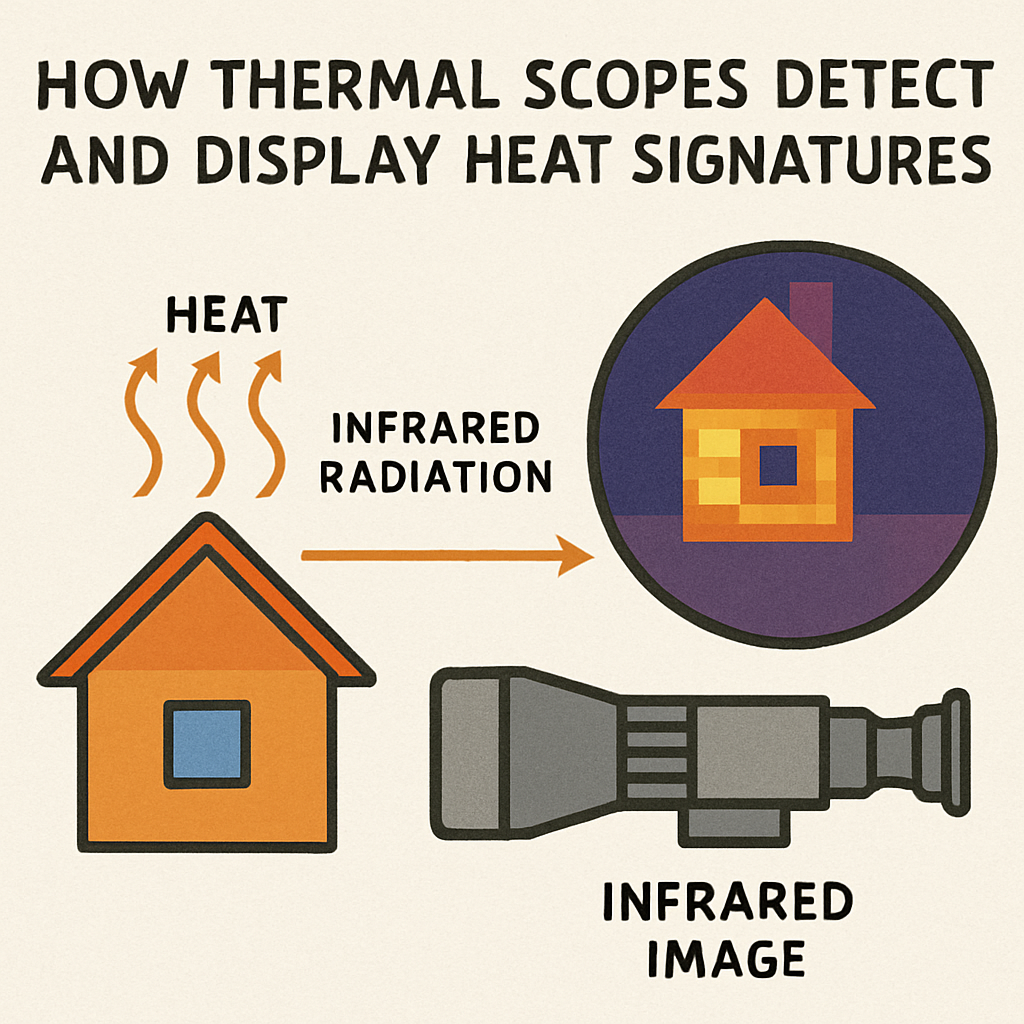
How Thermal Scopes Work: From Heat to Image
Thermal scopes operate by capturing infrared radiation3. This radiation is a type of heat emitted by all objects. The scope’s sensor detects these heat signatures, irrespective of lighting conditions.
Once the sensor collects the infrared data, it processes this information. Advanced processors translate the data into a visual image. This allows the user to see a representation of the heat differences in the environment.
Here’s how the process typically flows:
- Detection: The scope picks up infrared radiation from objects.
- Conversion: Heat signatures are transformed into electronic data.
- Display: Data is turned into a visible image on the device’s screen.
This workflow enables users to distinguish between different heat sources. As a result, thermal scopes are incredibly useful in diverse situations. They can reveal hidden threats or targets that would otherwise be invisible.
Understanding these fundamentals can assist in leveraging thermal technology efficiently. It enhances situational awareness, whether for security or hunting.
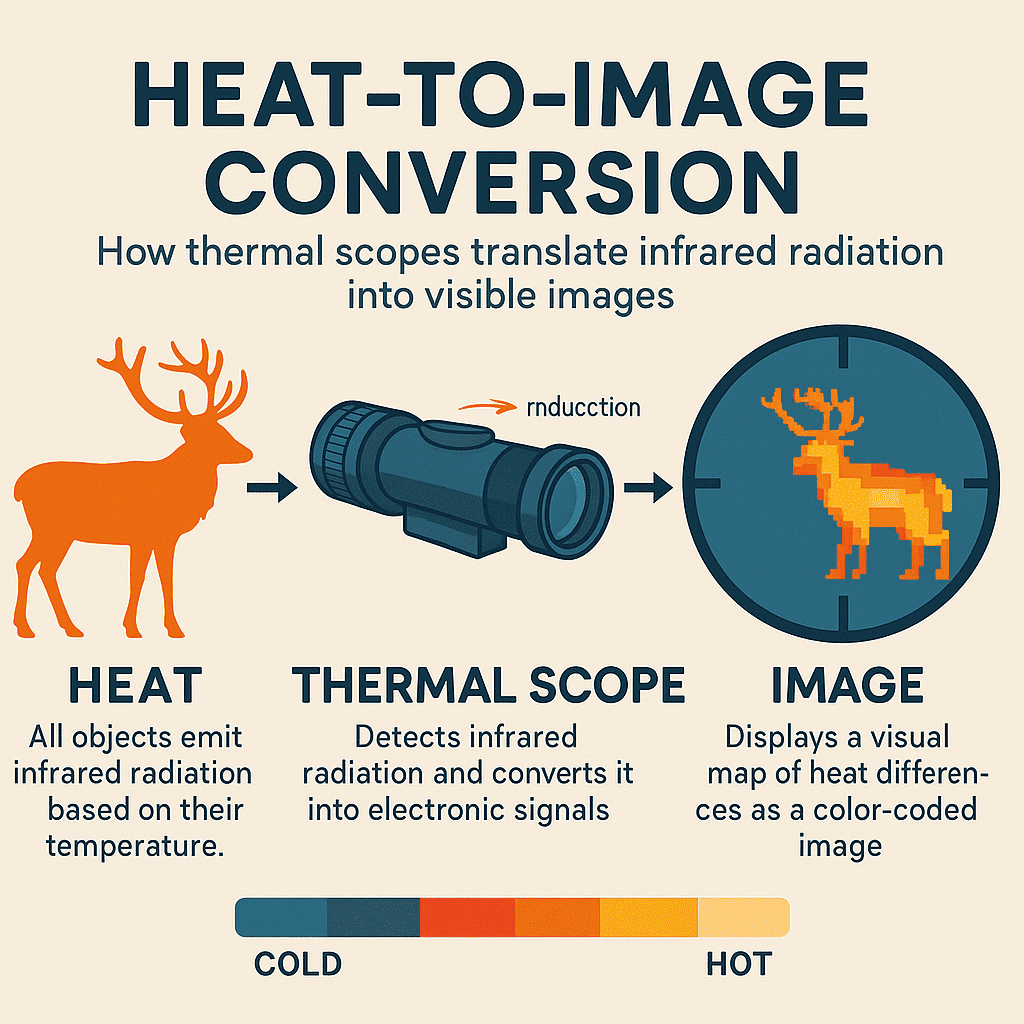
Key Components of a Thermal Scope
Thermal scopes comprise several essential components that work together to visualise infrared data. Understanding these parts helps users maximise their scope’s potential.
The core of any thermal scope is the lens. It collects infrared radiation, directing it to the sensor. High-quality lenses ensure clear and precise thermal imaging.
Next, the sensor arrays4 are critical. These sensors detect heat differences and convert them into a digital signal. Better sensors offer greater sensitivity and finer detail.
Processing units play a vital role as well. They interpret the sensor data, translating it into images displayed on the screen. Powerful processors reduce lag and increase the clarity of imagery.
Lastly, the display screen allows users to view thermal images. Modern scopes offer high-resolution screens for enhanced viewing. Each component is integral to the overall performance of the scope.
- Lens: Captures and focuses infrared light.
- Sensor: Detects and converts heat data into signals.
- Processor: Transforms signals into visible images.
- Display: Shows the generated thermal imagery.
Understanding these components fosters informed decision-making and enhances usage efficiency.
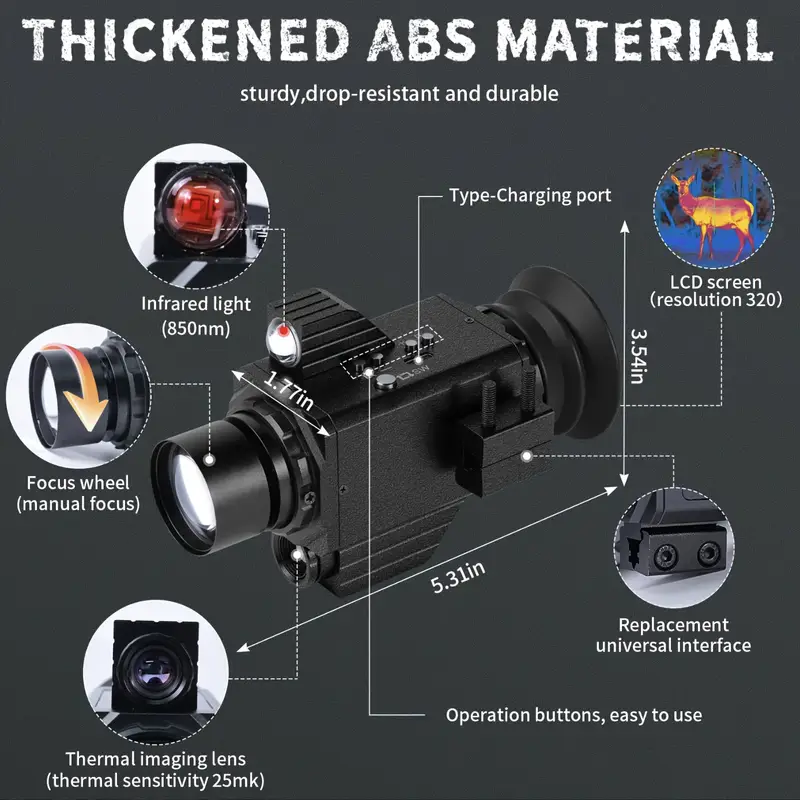
Thermal Scopes vs. Night Vision: What’s the Difference?
Thermal scopes and night vision devices are often confused, yet they operate differently. Both enhance visibility in low-light conditions, but their technology is distinct.
Night vision amplifies available light, including moonlight and starlight, to create visible images. It requires some ambient light to function effectively.
In contrast, thermal scopes detect heat signatures. They visualise differences in temperature between objects, functioning in total darkness without any light source.
Here’s a quick comparison:
- Night Vision: Relies on light amplification; struggles in absolute darkness.
- Thermal Scopes: Detect heat; work in complete darkness.
Understanding these differences helps select the right tool for specific needs, whether for hunting, security, or surveillance.

Types of Thermal Scopes and Optics
Thermal scopes come in various types, each tailored for different applications. Their diversity means there’s a perfect option for every need.
Handheld thermal scopes5 are portable and versatile. They’re ideal for scouting and can be used independently of firearms.
Meanwhile, weapon-mounted scopes are designed to attach directly to rifles. They’re popular in hunting and tactical scenarios for seamless integration.
Additionally, clip-on thermal optics offer flexible solutions. These can convert a daytime scope into a thermal one without recalibration.
Some types include:
- Handheld Scopes: Easy to carry; for scouting.
- Weapon-Mounted Scopes6: Attachable to firearms.
- Clip-On Optics: Versatile; enhances day scopes.
Choosing a type depends on your specific applications and intended use.
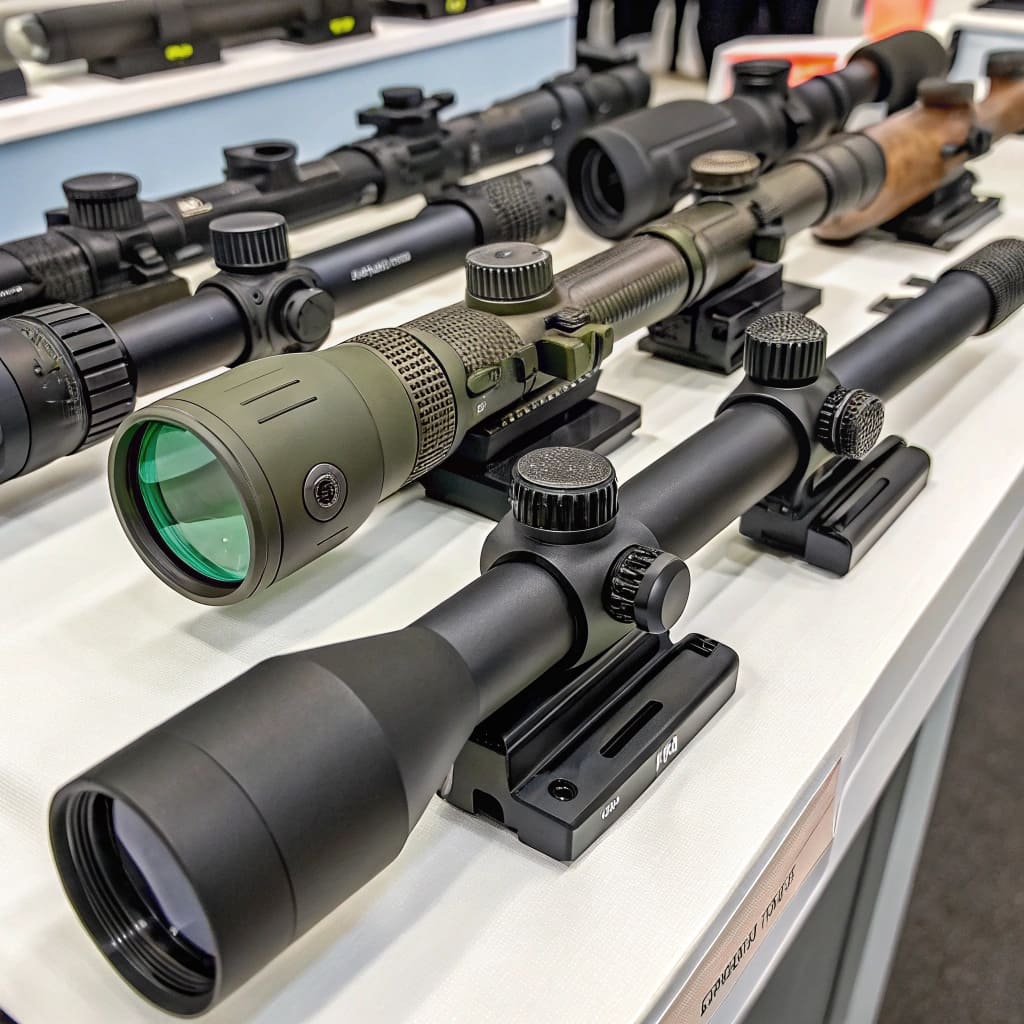
Core Features to Consider When Choosing a Thermal Scope
Selecting the right thermal scope involves considering several key features. Each feature impacts performance and suitability for specific tasks.
Resolution is crucial for image clarity. High resolution enhances detail, making it easier to identify targets.
The detection range determines how far a scope can effectively spot heat sources. Longer ranges are essential for wide-area surveillance.
The refresh rate affects how smooth the images appear. Faster refresh rates provide better performance, especially for moving targets.
Additional features often enhance versatility. For example, some scopes include rangefinders or video recording capabilities.
Important features to consider:
- Resolution: Affects image clarity.
- Detection Range: Determines spotting distances.
- Refresh Rate: Impacts image smoothness.
- Extras: Rangefinders, video recording.
For hunting, a scope with a fast refresh rate and good resolution is beneficial. Security operations might.
Applications: Security, Hunting, and Beyond
Thermal scopes are incredibly versatile. They offer unique advantages across various applications. Both security personnel and hunters find them indispensable.
In security operations, thermal scopes enhance surveillance. They effectively detect intruders in low-light conditions. Security managers value these tools for their proactive capabilities.
Hunters use thermal scopes for spotting wildlife at night. This technology is particularly useful for hog and coyote hunting. It allows hunters to detect animals obscured by darkness or foliage.
Beyond these common uses, thermal scopes are beneficial in search and rescue missions. They help locate missing persons in challenging environments.
Key applications of thermal scopes:
- Security: Enhanced surveillance and threat detection.
- Hunting: Night and obscured-view wildlife tracking.
- Search and Rescue: Locating individuals in low visibility.
Thermal technology’s adaptability makes it valuable. It meets the needs of diverse fields effectively.
Integrating Thermal Scopes into Security Operations
Integrating thermal scopes into security operations requires careful planning. They offer enhanced monitoring capabilities. These scopes can significantly upgrade existing systems.
Security managers should ensure compatibility with current technologies. Effective integration involves evaluating technical specifications. They must match the desired security objectives.
Thermal scopes improve threat detection7, especially in critical areas. They detect heat signatures even when intruders hide in shadows. This ability is crucial for maintaining secure perimeters.
Key integration steps include:
- Assess Compatibility: Ensure scopes align with existing systems.
- Training: Staff must understand thermal imaging.
- Regular Updates: Keep devices updated for optimal performance.
Implementing these tools boosts surveillance effectiveness. Proper integration ensures maximum return on investment.
Top Use Cases: Hog and Coyote Hunting, Law Enforcement8, and Surveillance
Thermal scopes are valuable in hunting nocturnal animals like hogs and coyotes. These creatures are active at night, making traditional methods less effective. Thermal optics help hunters spot them based on heat emission.
In law enforcement, thermal scopes are essential tools. They assist officers in locating hidden suspects. These devices can identify body heat through barriers such as walls and dense vegetation.
Surveillance operations greatly benefit from thermal imaging. It enhances perimeter security during both day and night. Detecting intruders becomes easier, regardless of lighting conditions.
Key use cases include:
- Hog Hunting9: Effective tracking of nocturnal animals.
- Coyote Hunting: Spotting heat signatures in darkness.
- Law Enforcement: Locating suspects in difficult environments.
- Surveillance: Maintaining security with reliable monitoring.
Understanding Specifications: Resolution10, Range, and Refresh Rate11
When selecting a thermal scope, understanding key specifications is crucial. Resolution affects image clarity. Higher resolution means more detail in the thermal image.
The detection range determines how far the scope can accurately identify heat signatures. It varies by model, influencing suitability for different purposes. Longer ranges are ideal for expansive terrains.
Refresh rate influences how smoothly the image updates as you scan. Faster refresh rates ensure the image keeps up with movement, crucial for tracking dynamic targets.
Key specifications to consider include:
- Resolution: Defines image clarity and detail.
- Range: Determines effective distance for heat detection.
- Refresh Rate: Affects the fluidity of image motion.
Understanding these specifications helps in choosing the right thermal scope. Matching these features with your needs ensures optimal performance.
Price Ranges: How Much Does a Thermal Scope Cost?
Thermal scopes vary significantly in price. Entry-level models can be surprisingly affordable. Basic units start under $1,000.
Mid-range scopes offer improved features. They typically range from $1,000 to $3,000. These models balance cost and performance, appealing to casual users.
High-end thermal scopes can exceed $5,000. They offer superior resolution and advanced features. Such models are favoured by professionals for demanding applications.
Here’s a breakdown of thermal scope price categories:
- Budget-Friendly: Under $1,000
- Mid-Range: $1,000 – $3,000
- High-End: $5,000 and above
Selecting the right scope depends on your budget and usage needs.
Best Thermal Scopes for Different Needs and Budgets
Choosing a thermal scope involves balancing features with cost. Different users have varied needs and budgets. Here’s how to navigate the options effectively.
For budget-conscious buyers, focus on essentials like resolution and range. Affordable models can still provide quality thermal imaging. These options ensure you don’t compromise on basic performance.
Mid-range scopes offer additional features, such as improved clarity and rangefinders. They cater to serious enthusiasts who require advanced functionality. These scopes provide a significant upgrade without exceeding budget limits.
High-end thermal scopes are ideal for professional applications. They boast excellent resolution, long-range capabilities, and advanced features. Such scopes cater to those who demand top-tier performance and reliability.
Consider the following when choosing a thermal scope:
- Budget Options: Basic features, ideal for entry-level users.
- Mid-Range: More features, suited for enthusiasts.
- High-End: Professional-grade, advanced capabilities.
Evaluate your specific needs to select the best scope within your budget.
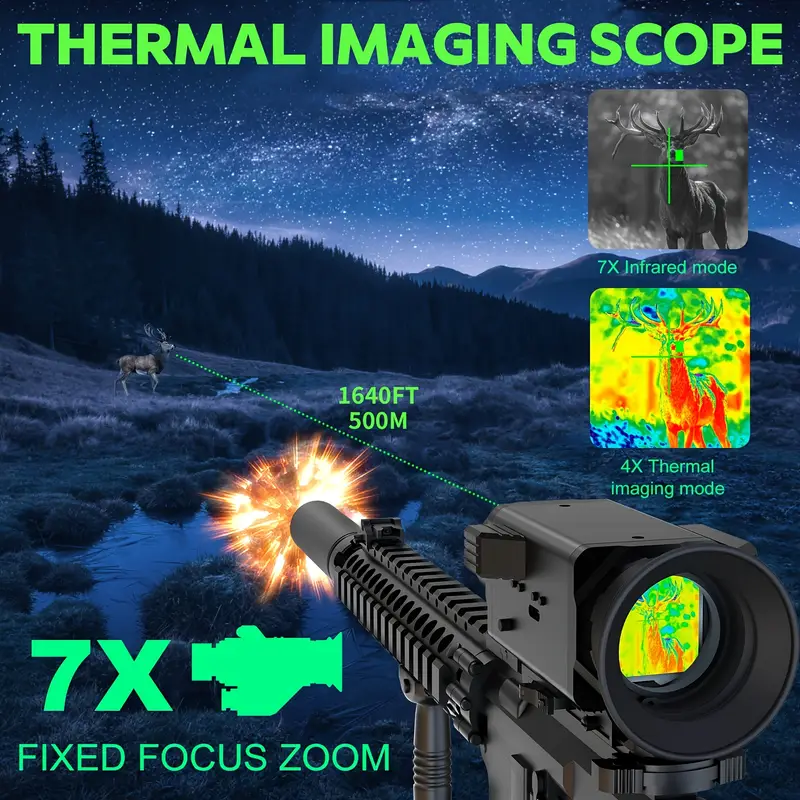
New Developments: What to Expect from Thermal Scopes in 2025
As we look to 2025, thermal scope technology promises exciting advancements. Expect significant improvements in resolution and battery life. Enhanced image clarity will redefine the capabilities of thermal optics.
Future models may incorporate AI for smarter detection and tracking. This evolution is set to revolutionise security operations and hunting experiences. The following developments are anticipated:
- AI Integration12: Smarter threat detection.
- Battery Enhancements13: Longer operational times.
- Improved Clarity: Sharper, clearer images.
These innovations will make thermal scopes more efficient and adaptable.
Maintenance, Battery Life, and Durability
Regular maintenance ensures your thermal scope functions effectively. Clean the lenses gently and store the device properly. This helps prolong its life.
Battery life14 varies among models but typically ranges from 5 to 10 hours. Opt for scopes with replaceable or rechargeable batteries for convenience. Consider the following durability aspects:
- Water-Resistant15: Suitable for diverse environments.
- Shockproof: Withstands impact and drops.
- Weatherproof: Operates in extreme conditions.
A durable thermal scope withstands rigorous use and harsh weather.
Frequently Asked Questions about Thermal Scopes
Thermal scopes can raise many questions for potential users. Below are answers to some common inquiries to help guide your understanding.
-
What is a good thermal scope?
A good thermal scope has clear resolution, a decent range, and reliable battery life. It should match your specific use, whether hunting or security. -
How much does a thermal scope cost?
Prices vary widely. Budget models are under $1,000. Premium options can exceed several thousand, depending on features and brand. -
Can thermal scopes be used during the day?
Yes, thermal scopes are effective both day and night. They detect heat, not light, so lighting conditions don’t matter. -
What is the best thermal scope for hunting?
It depends on your target and terrain. Consider weight, range, and durability to choose the best thermal scope for your hunts.
Conclusion: Making the Right Choice for Your Needs
Choosing a thermal scope involves understanding both your requirements and the device’s capabilities. Matching the scope to your specific needs ensures optimal performance in your intended application.
Evaluate the key features like resolution and range before purchase. Making an informed decision will enhance your security or hunting experiences effectively.
-
Learn about heat signatures and their role in thermal imaging to better appreciate the technology’s applications in security and hunting. ↩
-
Explore this link to understand how thermal scopes enhance security and improve threat detection in various environments. ↩
-
Exploring this link will deepen your understanding of infrared radiation, crucial for grasping how thermal scopes function. ↩
-
Learn about sensor arrays to understand their importance in thermal scopes and how they enhance image quality. ↩
-
Explore this link to understand the advantages of handheld thermal scopes for scouting and versatility. ↩
-
Discover how weapon-mounted scopes improve accuracy and integration in hunting and tactical scenarios. ↩
-
Learn more about the role of thermal imaging in threat detection and its importance in security measures. ↩
-
Discover how thermal imaging technology aids law enforcement in improving safety and operational effectiveness. ↩
-
Explore this link to understand how thermal scopes enhance hog hunting efficiency and success rates. ↩
-
Exploring this link will deepen your understanding of how resolution impacts image clarity in thermal scopes. ↩
-
This resource will explain the significance of refresh rate in ensuring smooth image updates for tracking targets. ↩
-
Explore how AI can enhance thermal scopes for smarter detection and improved performance. ↩
-
Learn about the latest battery technologies that extend the operational life of thermal scopes. ↩
-
Understanding battery life is crucial for choosing a reliable thermal scope that meets your needs. ↩
-
Exploring water-resistant features can help you select a thermal scope suitable for various environments. ↩
